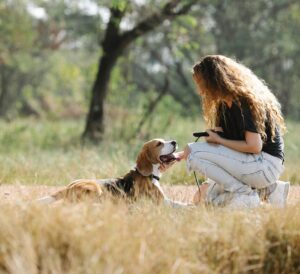 Every trainer quickly learns that dog training isn’t just about the dogs. It means teaching people, too. Your clients need to wrap up each dog training session with enough canine savvy to guide their dog toward success. When they get home, your client may have to relay your lesson to the other human members of their household, too. You are training your client to teach other people, as well as their dog!
Every trainer quickly learns that dog training isn’t just about the dogs. It means teaching people, too. Your clients need to wrap up each dog training session with enough canine savvy to guide their dog toward success. When they get home, your client may have to relay your lesson to the other human members of their household, too. You are training your client to teach other people, as well as their dog!
It can be hard to keep all these human needs in mind when you’re hyper-focused on the dog’s individual behavior. So, let’s identify a few essential “people factors” to keep in mind as you develop a dog training plan of action for your clients.
The best training plan is one that fits your client’s lifestyle
Because every dog is different, dog trainers tailor their training plans to meet the needs of the dog and their human handler. But there are aspects of your client’s lifestyle that they may not think to share with you, or that they may not realize are important. Sometimes even a simple omission or assumption can mean your client isn’t really able to follow your plan as you intended. While you can’t account for every unique aspect of your client’s lifestyle, here are a few client questions that can help you develop a plan they’ll comprehensive and follow more easily.
6 client talking points that will help you develop your dog training plan
1. Who will be the primary trainer at home? In an ideal world, every dog would receive most of their instruction from one person, and that person will bring the dog to your training sessions together. But let’s face it – a dog’s family sometimes includes a partner, or a set of parents, kids, and even neighbors or close friends who visit frequently. The dog’s family may not realize that it’s best if the person who brings the dog to the class also be the key person working with the dog at home. Progress will also be difficult if your instructions don’t filter accurately to the rest of the household, and everyone is using their own favorite cue words instead of the ones you have suggested.
Your training plan or client briefing should explain why it’s so important for the same person to attend every training class, and point out that real success depends on sharing the new desired skills and cues with the rest of the dog’s family. During class, have the client both demonstrate and briefly explain what they’ve learned that day, so they can feel more confident passing it on.
2. Where is the best location for their training session? If the dog is totally stressed out by car trips or is simply unable to focus in class with other dogs around, the client may be distracted, worried, or embarrassed as well. A group class isn’t the best learning environment for every dog and handler. You may want to offer some clients the option of home sessions or a private class, at least until the dog has had an opportunity to successfully practice focusing.
3. How will dog training fit into your client’s day? Some people have lots of opportunities to interact with their dog on both weekdays and weekends. But if the client is out the door at 5AM to commute to work and doesn’t get home until nine at night, you may want to suggest that another family member take on the role of primary trainer. If your client is home three weeks out of each month, but then is out of town on a work trip for the final week, you’ll want to chat about who will step in to keep up the dog’s daily training.
4. Where will training practice take place outside of your class? Ask your client about their home and neighborhood. How busy are the yards and streets where your client lives? Is there another dog in the home who will also be learning these new behaviors and cues? Is a neighbor’s dog constantly barking through the backyard fence? When you are aware of other distractions your client is also trying to juggle, you can include some tips in your training plan on how to avoid or mitigate them.
5. What are your client’s long term goals in seeking dog training help? Of course, everyone generally wants a “well-behaved dog.” But, especially with adult dogs, there are usually particular behaviors your client is most concerned about. If the client’s primary desire is to have a dog who politely walks on-leash in the neighborhood without pulling or lunging toward other dogs and people, your training plan will stress skills like focusing on the handler instead of other dogs, walking on a leash, emergency recall, etc. If instead the client wants a dog who doesn’t knock down the kids or jump on visitors, your training plan will focus on different redirection techniques, like sending their dog to their bed or a mat near the front door to await a reward before greeting newcomers. Even in a targeted class like loose leash training, one client’s goal may be to have a dog who doesn’t take off for a two-day jaunt if they pull the leash away from their handler, and another client may want to have a dog who doesn’t lunge and bark at other canines. By asking outright, you can accurately adjust each client’s training plan right at the start.
6. Ask your client to focus on how they want their dog to behave, instead of what they want them to stop doing. Encourage your clients to note those positive moments when their dog responds to a new cue with the desired behavior, or when their dog is successfully redirected from an unwanted behavior to the new one. Very few dogs are going to stop door-rushing, barking, or leash-pulling right away. Some may always have an impulse toward the old behavior, and may always need to be redirected with a cue. Chances are, when or if the undesired behavior entirely disappears, it will be a sudden realization that at some point their dog stopped testing the leash without them really noticing. Until that day, suggest your client concentrate on all those positive moments when their dog correctly responds.
Dog training takes time. A client is more likely to stick with it if they are able to see and acknowledge the increasingly positive improvement in their dog’s behavior, versus waiting for the undesired behavior to suddenly disappear.
 Address confusion with a listening ear
Address confusion with a listening ear
You can feel a bit like a superhero when you’ve been instrumental in helping to forge a lot of truly happy, successful human/dog partnerships. So, when the majority of your clients seem to be getting it and only one person is confused or impatient, it’s tempting to think “It’s not my teaching – they just aren’t listening.”
If a client seems super-confused, it’s natural to try to make things clearer by repeating instructions or providing more examples. Unfortunately, when some people are overwhelmed they may push back even harder or, worse yet, shut down and pretend to understand.
Instead of explaining everything over and over again to a client who just doesn’t seem to “get it,” invite them share exactly where they are hitting a roadblock. Let them know that it’s understandable to have questions when it comes to trying to comprehend and guide a living animal’s behavior. After all, there’s good reason why there are certification programs in dog training and behavior! Walk them through your training plan or the day’s lesson, and invite them to say “stop” when things start feeling muddy or a term doesn’t seem clear. You can then simplify your instruction to address just the spot where they have lost their way.
Keep your feedback short and direct
Long summaries are out — clear and succinct info is in. Nowadays, people scan for important info and scroll on by the rest, so it’s important for your feedback to fit this habit. Video-recording all or part of your training sessions with clients is a great way to provide clear feedback. Even a few short clips of their session on your smartphone can help them see how they work together with their dog. If video isn’t possible, you can also leave yourself voice notes on your smartphone during or after a class, so you don’t forget the most important points to follow up on. Check out Voice Notes for iPhone and there are several voice apps available for Android.
Then your written feedback can be short and sweet:
“Hey, it was great working with you and your dog today. Here are the key points we talked about. I will be sending over a video of the training session tomorrow, and I look forward to seeing you at the next visit. Here’s your homework until we meet again. Pick these two things to concentrate on, and I look forward to seeing you next week!”
The shorter and more direct your feedback is, the more likely your clients are to absorb and act on it.
Let the Victoria Stilwell Academy help you navigate client communication
There’s so much to learn about communicating with clients! We know that learning to design training plans that really click is as important as understanding dog behavior, so the Victoria Stilwell Dog Trainer Course includes a curriculum on Human Communication & Psychology. Check out a summary of our full course curriculum here and consider adding the successful completion of our Dog Training Course to your future business plan!

 Address confusion with a listening ear
Address confusion with a listening ear

